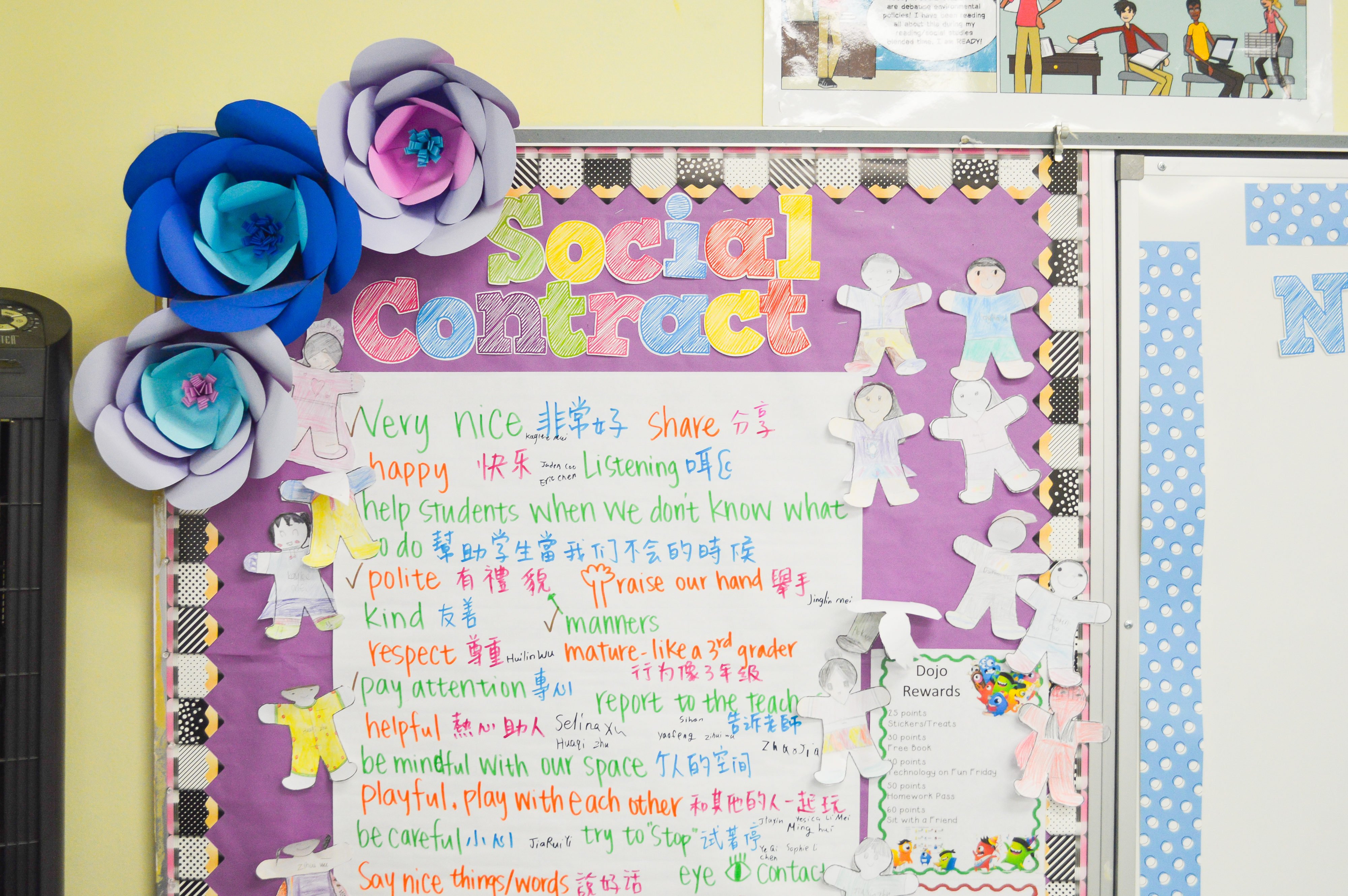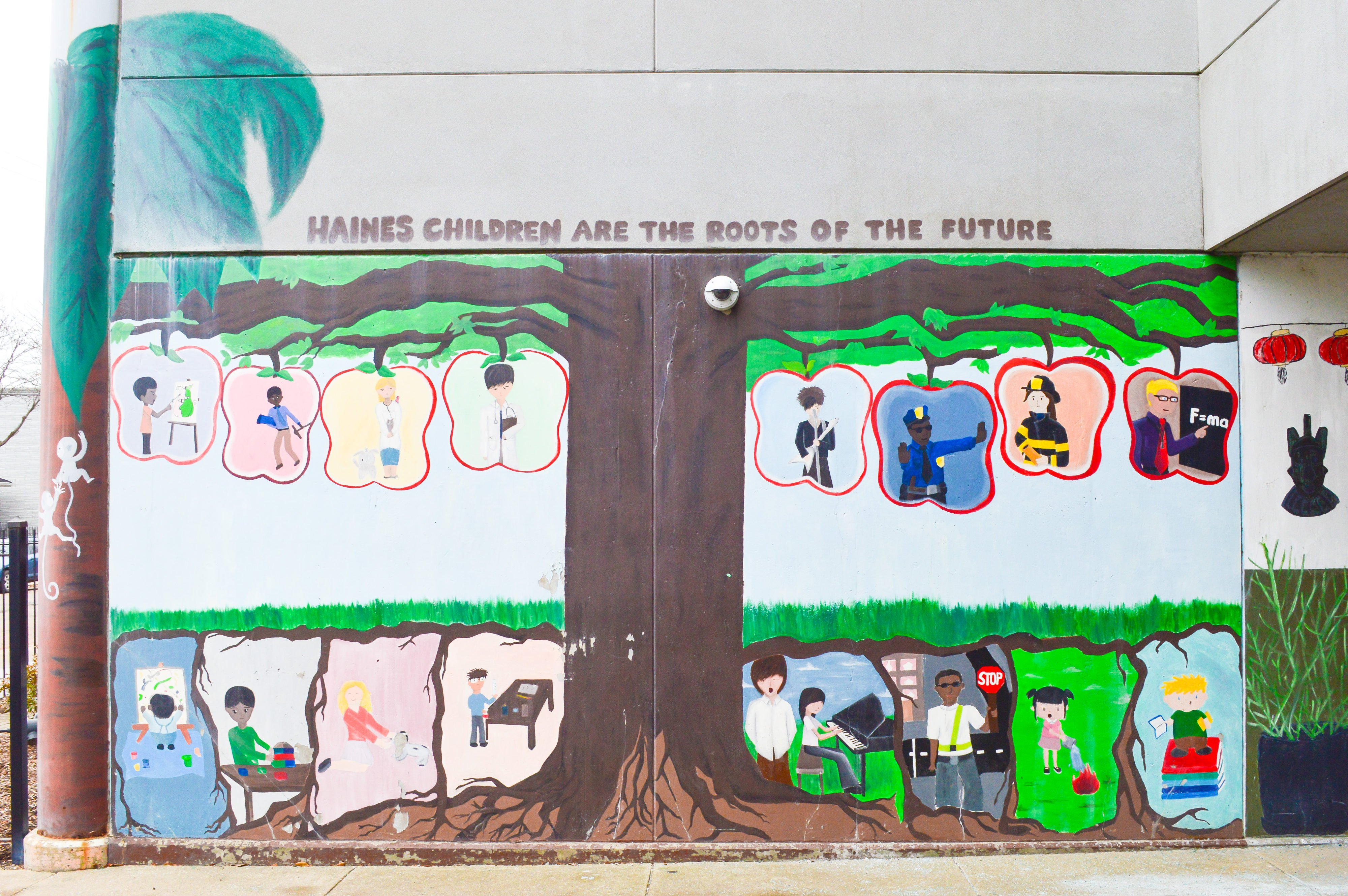The Power of Community | El poder de la comunidad
23 January 2020
Second grade teacher Jenny Ma will never forget the time she received a Christmas card from a student.

Why Haines Elementary is an Irreplaceable Piece of Chicago’s Chinatown Neighborhood
Second grade teacher Jenny Ma will never forget the time she received a Christmas card from a student. It didn’t matter that the card was meant for Valentine’s Day or that it was in Spanish or that she wasn’t even the student’s teacher. What mattered to her was the student had taken the time to thoughtfully select a Minnie Mouse card because she knew Ms. Ma loved Disney movies. As a Haines Elementary graduate herself, Ms. Ma knows that strong relationships between teachers, students, and parents create these special interactions on a daily basis.
“What I love about coming to Haines every day is working with my colleagues,” she said. “The students and parents are very respectful and they value education, which leads to lots of collaboration between teachers and parents.”
Nestled in the heart of Chicago’s Chinatown neighborhood, Haines has the largest percentage of Asian-American students of any CPS school and is also home to many English Learners. Because Haines welcomes a steady stream of students who are new United States residents, school staff work tirelessly to ensure that all students successfully acclimate to the school’s environment and that families are smoothly adjusting to life in Chicago. Bilingual specialist May Cheung says that having compassionate staff members who know Chinatown well helps parents find a community and resources in their neighborhood that they might have missed otherwise.
“I always want to make sure that when parents first come to Haines, they know about everything, from our parent meetings to English learning classes at local churches,” Ms. Cheung said. “I also encourage them to start building their own networks and to help each other out.”
Because students often enter Haines with limited English proficiency, having a robust strategy for developing bilingualism is a key piece of the school’s instructional methods. Ms. Ma and Ms. Cheung agree that the path towards bilingualism always begins with honoring a student’s native language. Then, by gauging how much of a language a student already knows, teachers can build upon those skills to help students learn phonics, build vocabulary, and master sentence structure in tandem. Little by little, students learn how to decode—not just translate—everything from picture books to math word problems.
“We know that coming to a new environment, making new friends, and learning a new language is a lot for our students,” said Ms. Ma. “We try to convey the message that we value bilingualism by telling them that, at the beginning, it’s okay to express things in their native language. That provides a sense of comfort for them.”

As well as recognizing students’ diverse backgrounds inside the classroom, Haines also goes above and beyond to make sure it celebrates its community’s cultural heritage. Ms. Ma says the school goes “all out” for Chinese New Year with a huge celebration featuring traditional lion dances, Chinese almond cookies, and hallways full of students wearing red—a lucky color in China. The school also takes part in the annual Chinese New Year parade in Chinatown. Additionally, Haines supports its community consistently in its day-to-day operations. For example, the school makes sure that all flyers or announcements are always translated into students’ native languages as well.
“The Chinatown community is a safe and strong community, and we help out each other,” said Ms. Cheung. “I am working in Chinatown because I want to serve my people.”
In addition to celebrating its cultural strengths, Haines also expands students’ perspectives through extracurriculars and external partnerships. Teachers often take students to academic competitions on Saturdays, which gives students an opportunity to visit different parts of the city and compete and learn with their classmates. Haines also produces a Disney musical each year through a partnership with the Goodman Theatre, which immerses students in the arts while helping shy students come out of their shells. Ultimately, Ms. Ma and Ms. Cheung say these opportunities prepare students for life once they graduate from Haines.
“I want our students to be able to merge into mainstream society—not just in Chinatown,” said Ms. Cheung. “They’re good kids; they do well in school, but sometimes they need to get outside of their comfort zone and explore different opportunities for themselves.”
Community members who walk past Haines are greeted with a mural that says: “Haines children are the roots of the future.” And with its foci on bilingualism, preserving students’ cultural identities, and providing enriching extracurricular opportunities, it is hard not to picture Haines as a giant tree, providing students with the skills they need to grow, branch off, and reach their dreams.

Por qué la Haines Elementary es una parte irremplazable del Barrio Chino de Chicago
Jenny Ma, maestra de segundo grado, nunca olvidará que una vez recibió una tarjeta de Navidad de una estudiante. No importaba si la tarjeta era para el día de San Valentín, o contenía un mensaje en español, o si ella ni siquiera era su maestra. Lo que le importaba era que la estudiante se había tomado el tiempo de seleccionar cuidadosamente una tarjeta de Minnie Mouse, porque sabía que a Ma le encantaban las películas de Disney. Como una graduada de la Haines Elementary, Ma sabe que las fuertes relaciones entre los maestros, los estudiantes y los padres crean estas interacciones especiales diariamente.
“Lo que me gusta de la escuela Haines es poder trabajar con mis colegas todos los días”, dijo. “Los estudiantes y los padres son muy respetuosos y valoran la educación, lo que lleva a mucha colaboración entre los maestros y los padres”.
Ubicado en el centro del Barrio Chino de Chicago, la escuela tiene el mayor porcentaje de estudiantes asiático-americanos de todas las escuelas de CPS, y también es el hogar de muchos estudiantes de inglés. Debido a que la escuela recibe a un flujo constante de estudiantes que son nuevos residentes de los Estados Unidos, el personal trabaja incansablemente para asegurar que todos los estudiantes se familiaricen con el ambiente escolar, y que las familias se adapten con facilidad a la vida en Chicago. May Cheung, especialista bilingüe, dice que tener empleados compasivos, que conocen bien el Barrio Chino, ayuda a los padres a encontrar una comunidad y recursos en su vecindario. Sin el personal, los padres podrían desaprovecharlos.
“Siempre quiero asegurarme de que cuando los padres vienen a la escuela por primera vez estén informados de todo, ya sea sobre nuestras reuniones de padres, o las clases de inglés en las iglesias locales”, dijo. “También les animo a que empiecen a crear sus propias redes, y se ayuden entre sí”.
Debido a que muchas veces los estudiantes ingresan a la escuela con un dominio limitado del inglés, tener una sólida estrategia para el desarrollo del bilingüismo es uno de los principales métodos de enseñanza de la escuela. Ma y Cheung están de acuerdo en que el camino hacia el bilingüismo siempre empieza por honrar el idioma nativo de los estudiantes. Entonces, los maestros se basan en su competencia lingüística para enseñarles la fonética, y al mismo tiempo, ayudarles a ampliar su vocabulario y a dominar la estructura de la oración. Poco a poco, los estudiantes comienzan a comprender— y a interpretar en su propio idioma— el contenido de libros ilustrados y de problemas matemáticos.
“Sabemos que venir a un nuevo ambiente, hacer nuevos amigos y aprender un nuevo idioma es mucho para nuestros estudiantes”, dijo Ma. “Tratamos de transmitir el mensaje de que valoramos el bilingüismo diciéndoles que, al principio, está bien expresar las cosas en su idioma nativo. Eso les da una sensación de alivio”.
Además de reconocer los diversos orígenes de los estudiantes dentro del aula, la escuela también va más allá de lo requerido para garantizar la celebración del patrimonio cultural de su comunidad. Ma dice que la escuela “se esfuerza al máximo por festejar el Año Nuevo Chino” con una gran celebración que incluyen danzas tradicionales del león, galletas de almendra chinas y pasillos repletos de estudiantes vestidos de rojo, un color de la suerte en China. También participa en el desfile anual del Año Nuevo Chino en el Barrio Chino. Asimismo, apoya a su comunidad consistentemente en sus operaciones diarias. Por ejemplo, se asegura de que todos los folletos o los anuncios se traduzcan siempre a los idiomas nativos de los estudiantes.
“La comunidad del Barrio Chino es una comunidad segura y fuerte, y nos ayudamos mutuamente”, dijo Cheung. “Trabajo en Chinatown porque quiero servir a mi pueblo”.
Además de celebrar sus fortalezas culturales, la escuela Haines también amplía las perspectivas de los estudiantes, por medio de las actividades extracurriculares y las asociaciones externas. Los sábados, los maestros suelen llevar a los estudiantes a las competencias académicas, lo que les da la oportunidad de visitar diferentes partes de la ciudad, de competir y de aprender con sus compañeros de clase. Cada año, la escuela también produce un musical de Disney por medio de una asociación con el Goodman Theatre, que sumerge a los estudiantes en las artes, mientras ayuda a algunos a ser menos tímidos. Y por último, Ma y Cheung dicen que estas oportunidades preparan a los estudiantes para la vida postsecundaria.
“Quiero que nuestros estudiantes puedan integrarse en la sociedad, no solamente en el Barrio Chino”, dijo la maestra Cheung”. Son niños buenos; les va bien en la escuela, pero a veces necesitan salir de su zona de confort, y explorar diferentes oportunidades para ellos mismos”.
Los miembros de la comunidad que pasan frente a la escuela son recibidos con un mural que dice: “Los niños de Haines son las raíces del futuro”. Y con su enfoque en el bilingüismo, la preservación de las identidades culturales de los estudiantes, y la provisión de oportunidades extracurriculares enriquecedoras, es difícil no imaginar a la escuela como un árbol gigante, que les enseña a los estudiantes las habilidades que necesitan para crecer, ramificarse y alcanzar sus sueños.
Related Stories
09 May 2025
Learning Alongside My Students: Take Five with Melissa Flisk
Ms. Flisk strives to create a calm and welcoming environment that celebrates her students’ interests, needs, skills, and personalities.
07 May 2025
Learning All About an Amazing Art Educator for Teacher Appreciation Week
Natalie loves working with students, especially those who enter her classroom without a lot of confidence in their abilities.
07 May 2025
Celebrating Teacher Appreciation Week with an Outstanding Third-Grade Educator
Reem is doing an amazing job in her first year leading a classroom of her own.
05 May 2025
Making the World a Bigger and Better Place for Students with Visual Impairments
Ms. Segroves is dedicated to providing students with direct instruction and accommodations to help them access everyday instruction.




